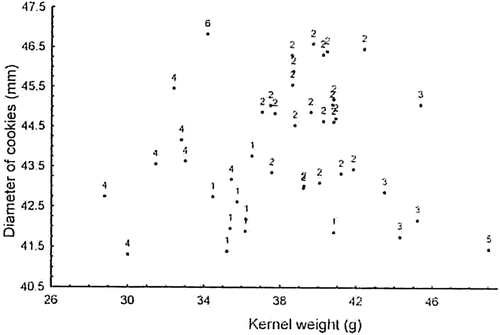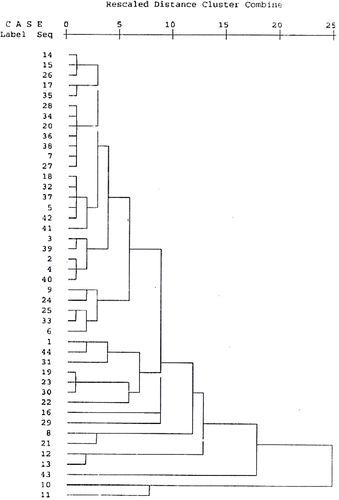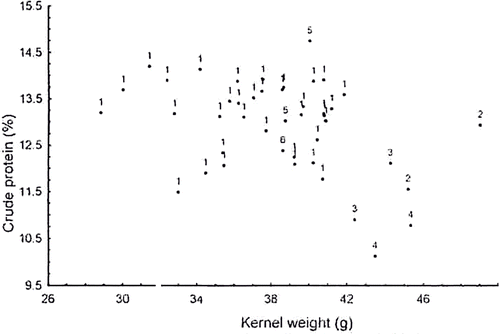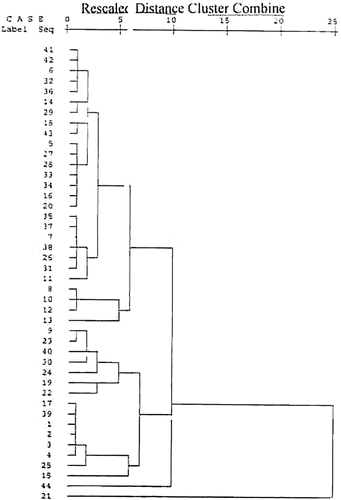Abstract
Spring wheat varieties were subjected to physico-chemical, mixographic and amino acid analysis. The data obtained was subjected statistically analyzed. The cluster analysis classification based on centroid method indicated that for lysine and overall cookie scores, generally most wheat varieties fell in one group, while for total chapati score most of the wheat varieties were classified into two groups. The wheat varieties falling in same cluster group have similarities in respect of lysine, chapati and cookie quality. This indicated that wheat varieties in Pakistan have narrow ranges of spectrum in their genetic make up for their quality attributes. However, some wheat varieties were distinguished into different groups having a wide distance range especially Shahkar 95 for lysine content, LU 26 and Punjab 96 for cookie quality and Punjnad 88 in case of chapati quality. The present grouping suggests that wheat varieties in cluster group with wider range for lysine content may be used further in a hybridization program to improve the nutritional quality of wheat.
INTRODUCTION
Multivariate techniques of analyzing statistical significant variation in data are being used in many disciplines and increasingly are employed to traits in wheat breeding program.[Citation1] The correlation of different quality parameters with end use quality attributes can be determined by using different statistical techniques. Endo et al.[Citation2] described that cluster analysis is a computerized multivariate technique that differentiates various items by analyzing data similarities. The results are shown by dendrograms based on several methods; a single linkage, complete linkage, median method, centroid method and group average or ward's method.
Graybosch et al.[Citation3] suggested that many protein components interact to determine quality. The predictive models using multivariate statistical techniques can be developed using protein components and their application to breeding hard red type bread wheats will not be of great value unless the number of components to be measured can be much reduced and their predictive ability increased. Murphy et al.[Citation4] used cluster analysis and suggested that it may be applied to parental selection of conventional cultivars, hybrid cultivars and population development in winter wheat.
The application of multivariate technique on quality data is limited in Pakistan and a few scientific studies have been carried out on quality contents wheats to develop predictive models. In the present study centroid cluster analysis classification was used to develop predictive model for some of the spring wheat varieties.
MATERIALS AND METHODS
Wheat varieties (Triticum aestivum L.) grown at Wheat Research Institute, Faisalabad were included in this study as shown in (). One kg wheat grain sample of each variety was tempered to 15.5% moisture level and milling was done according to AACC[Citation5] in Quadrumate Senior Mill. The whole wheat flour was prepared by milling the samples through Udy Cyclone Mill (UDY Corp. Colorado, USA). Physicochemical and mixographic properties were assessed by following the standard methods given in AACC.[Citation5]
Table 1 Codes of wheat varieties tested for various parameters
The amino acid analysis was done by using hydrolyzate of whole-wheat flour and chapaties of each wheat variety by using High Speed Amino Acid Analyzer (L-8500 A, HITACHI) according to the method given in AACC.[Citation5] The amino acid score was determined by following the method of FAO/WHO.[Citation6] The cahpaties were prepared according to the method of Haridas et al.[Citation7] The dough was prepared by adding 65–70% water in 200 g of flour and mixing was carried out for 3 minutes in a mixer (National Mfg. Co., Lincoln, Nebr.). A dough piece (after resting for one hour at room temp.) weighing 80 g was rounded and turned into chapaties by using specially designed platform with the help of rolling thermostatically controlled hot plate at a temperature of 210°C for 1.5 min. Cookies were prepared according to method as described in AACC.[Citation5] The cookies were baked at 220–230°C for 10 min., weighed and their volume was recorded by using the rapeseed displacement method as described by Haridas and Shurpalekar.[Citation8] The relationship of different quality traits with lysine and baking quality (chapatis and cookies) were computed by selecting significant variables using stepwise regression SPSS package. Centroid cluster analysis (Dendrogram) was performed (SPSS Package, V. 3.0, IBM Pentium 4 PC) for the arrangement of different wheat cultivars into groups on the basis of their internal similarity.
RESULTS AND DISCUSSION
The results of stepwise regression for lysine as dependent variable are given in the which indicated that lysine depends significantly and positively upon fat, volume, amino acid scores, crude protein and aspartic acid while it appeared to be dependent significantly and negatively on height, kernel weight, glycine, arginine and isoleucine. A 0.026 increase is observed with a unit increase in protein when the effect of other variables is kept constant. The unit increase in kernel weight, glycine, arginine, and isoleucine showed a decrease in lysine when effect of other variables kept constant.
Table 2 Significant variables contributing for dependent (lysine, total chapati scores, and Overall cookie quality scores) derived through stepwise regression
The regression coefficient presented in indicated that total chapatti score depended significantly and positively on breakability, colour, flavour/ taste, feel to touch, texture, and foldingability of chapatis while it is significantly and negatively influenced by crude fiber and lysine. Total chapati score increased by 1.01 units with a unit increase in flavour/ taste of chapati while decrease of 0.16 and 0.93 units in total chapati score with per unit increase in crude fiber and lysine respectively when the effect of other variables was kept constant.
The stepwise regression () that overall cookie quality score was significantly and positively depended on surface characteristics, crispiness, colour, taste and spread factor while it was negatively significant for ash, kernel weight and cookie diameter. It is clear from the table that overall cookie score increased by 1.00 with per unit increase in surface characteristics keeping the effect of other variables constant. On the whole it can be concluded that total chapati score increased by 2.4 with per unit increase in crude fat keeping effect of other variables constant. A decrease of 1.55 and 1.01 in total chapati score was reduced respectively by Butt[Citation9] when the effect of other variables kept constant. While interpreting the estimates of multiple regression, Muhammad[Citation10] stated that in practical problems, the sign of the parameter estimates may be opposite to a researchers understanding of the problem. Sensory properties like aroma, colour, volume of the bread is directly affected by flour quality Ayo et al.[Citation11]
The dendrograms derived from centroid cluster analysis in respect of lysine content of wheat varieties classified into six groups are depicted in & . It was observed that only 9 wheat varieties fell in groups 2, 3, 4, 5, and 6 while all other wheat varieties were categorized in group 1. This showed that 35 wheat varieties falling in group 1 were at the bottom in respect of rescaled distance cluster combine. The wheat varieties Barani 70 and Chenab 70 in group 3 and Shahkar 95 in group 6 were at a wide range of rescaled distance cluster combine as compared to other wheat varieties (). It is obvious from the results that wheat varieties in cluster group 3 followed by group 6, group 4, group 2, group 5, and group 1 can be classified in a descending order with respect to lysine content.
Table 3 Cluster analysis classification of wheat varieties based on lysine
F-ratio of kernel weight (426.5715) and crude protein content (92.8774) were higher than the remaining variables. Thus kernel weight and crude protein content were the most important variables in clustering of the wheat varieties for lysine content. The scatter plot () showed that cluster 2 was higher in kernel weight. Cluster 6 and one value from cluster 5 were in between cluster 1. One value from cluster 5 was higher in crude protein content.
Dendrograms of the cluster analysis classification based on total chapati scores have shown in . Arbitrarily applying rescaled distance cluster combine classified the dendrograms into six groups (). The group 2 comprised 21 wheat varieties. It was evident from the dendrogram that Punjnad 88 in group 6 was at the highest distance as compared to other wheat varieties falling in other cluster groups. Anjum et al.[Citation1] classified thirty wheat varieties by cluster analysis for chapati quality and found that most of wheat varieties fell in one or two groups.
Table 4 Cluster analysis classification of wheat varieties based on total chapati scores
Color of chapati was the most important variable in clustering of wheat varieties for total chapati scores as confirmed by large F-ratio (99.8557). The scatter plot for total chapati scores () indicated that cluster 4 was high while cluster 6 was low both in color and feel to touch of chapaties. One value from cluster 2 was high in color of chapaties and some values were high in feel to touch of chapaties.
Figure 4 Scatter plot of kernel weight and diameter of cookies for overall quality scores of cookies.

The results of cluster analysis based on overall quality scores of cookies bifurcated 23 wheat varieties in the same cluster (). The results in indicated that wheat varieties LU 26 in group 5 and Punjab 96 in group 6 were at a wide range of rescaled distance cluster combine as compared to other wheat varieties falling in other cluster groups. The wheat varieties falling in same cluster group have similarities in cookie quality. Srikaeo et al.[Citation12] stated that cooking temperature and conditions significantly affect the physicochemical properties of the different bakery products as in case of chapatis and cookies in this study.
Table 5 Cluster analysis of wheat varieties based on overall quality scores of cookies
The higher F-ratio of kernel weight (426.5715) and diameter of cookies (169.6231) confirmed that these were the important variables in clustering of the wheat varieties for overall cookie quality. indicated that cluster 5 was high in kernel weight. Cluster 6 and some values of cluster 2 were high in diameter. Cluster 4 was low both in kernel weight and diameter of cookies. Different techniques of cluster analysis were used by different workers and they found that it was useful for grouping the varieties for different parameters.[Citation2,Citation13 Citation14] Endo et al.[Citation2] described that cluster analysis indicated the similarities of wheat varieties within groups.
CONCLUSION
Stepwise regression gave significant information of some important parameters contributing significantly and positively towards loaf volume, bread and chapati score. Total chapati score increased by 2.4 with per unit increase in crude fat keeping the effect of other variables constant. A decrease of 1.55 and 1.01 in total chapati scores was recorded with per unit increase in ash and fiber content, respectively. The cluster analysis classification by centroid method in the present study indicated that for lysine and overall cookie score, generally most of wheat varieties fall in one group while for total chapati score most of the wheat varieties classified in two groups. The present grouping suggest that wheat varieties in cluster group with wider range for lysine content may be used further in hybridization program to improve the nutritional quality. Thus the grouping of wheat varieties by cluster analysis will be helpful for the breeders to plan their breeding program in both nutritional and technological quality improvement.
REFERENCES
- Anjum , F.M. , Butt , M.S. , Dick , J. Z. and Ahmad , I. 2002 . Classification of quality of spring wheats by cluster analysis . Int. J. Food Sci.and Technol. , 37 : 101 – 106 .
- Endo , S. , Okada , K. , Nagao , S.D. and Appolonia , B.L. 1990 . Quality characteristics of hard red spring and winter wheats. II. Statistical evalution of reversed-phase high-performance liquid chromatography and milling data . Cereal Chemistry , 67 : 486 – 489 .
- Primard , S. , Graybosch , R. , Peterson , C. J. and Lee , J.H. 1991 . “ Relationship between Wheat Quality and Gluten Protein Composition in Flour Protein Hard Red Winter Wheat Breeding Populations ” . In Gluten Proteins , Edited by: Bushuk , W. and Tkachuk , R. 581 – 594 . St. Paul, MN : American Association of Cereal Chemists, Inc .
- Murphy , J.P. , Cox , T.S. and Rodgers , D.M. 1986 . Cluster analysis of red winter wheat cultivars based upon coefficients of parentage . Crop Science , 35 : 672
- American Association of Cereal Chemists . 2000 . “ Approved Methods of AACC ” . In American Association of Cereal Chemists, Inc St. Paul, MN
- FAO/WHO . Energy and protein requirements. FAO/WHO/United Nations University Expert Consultation . Technical Report Series No. 724 . 1985 . World Health Organization, Geneva
- Haridas , R.P. , Leelavathi , K. and Shurpalekar , S.R. 1986 . Test baking of chapati-development of a method. Cereal Chemistry . 63 : 297 – 303 .
- Haridas , R.P. and Shurpalekar , S.R. Utilization of milk in bakery products . Journal of Food Science and Technology , 1976 ( 13 ) 293 – 299 .
- Butt , M.S. 1997 . Physico-chemical and protein composition of spring wheats in relation to end use quality , Faisalabad, , Pakistan : Ph.D. Thesis, Dept. Food Tech., Univ. Agric .
- Muhammad , F. 1995 . Statistical methods and data analysis , Faisalabad, , Pakistan : Deptt. Methemtics and Statistics, Univ. Agric .
- Ayo , J A. 2001 . The Effect of Amaranth Grain Flour on the Quality of Bread . Int. J of Food Prop. , 4 ( 2 ) : 341 – 351 .
- Srikaeo , K.F. , John , E. , Hosken , R.W. and Ashton , J.F. 2005 . Physical Properties of Cooked Wheat Grains as Affected by Cooking Temperature and Duration . International Journal of Food Properties , 8 ( 3 ) : 469 – 479 .
- Brown , J.S. 1991 . Principal component and cluster analysis of cotton cultivar variability across the U.S. cotton belt . Crop Science , 31 : 915
- Revilla , P. and Tracy , W.F. 1995 . Isozyme variation and phylogenetic relationships among open-pollinated sweet corn cultivars . Crop Science , 35 : 219




